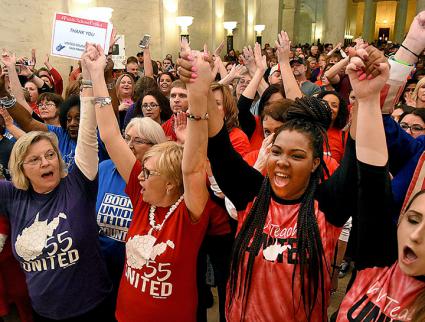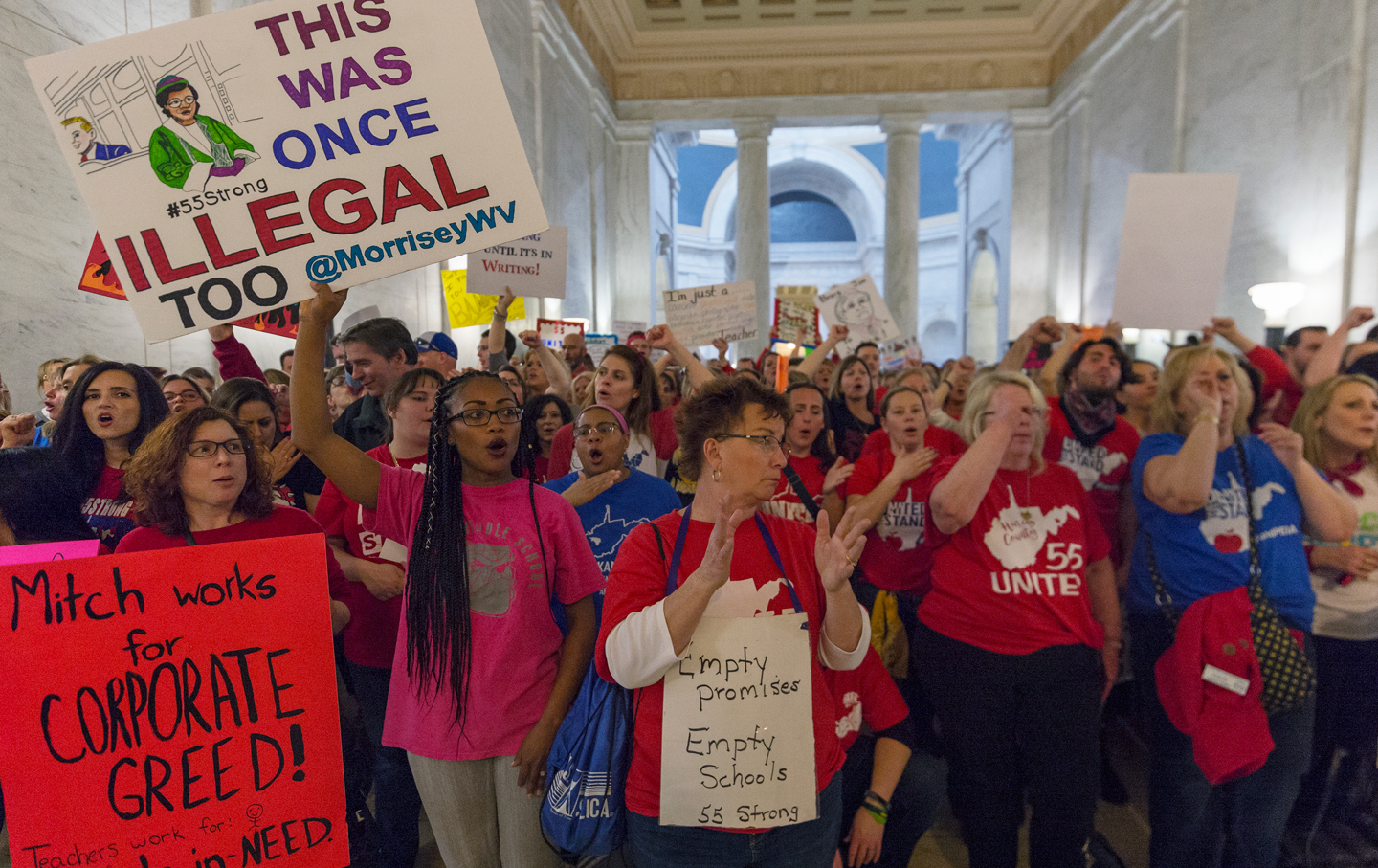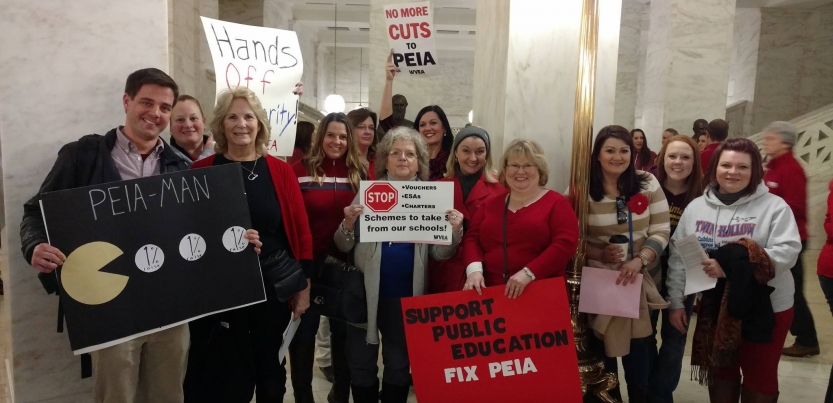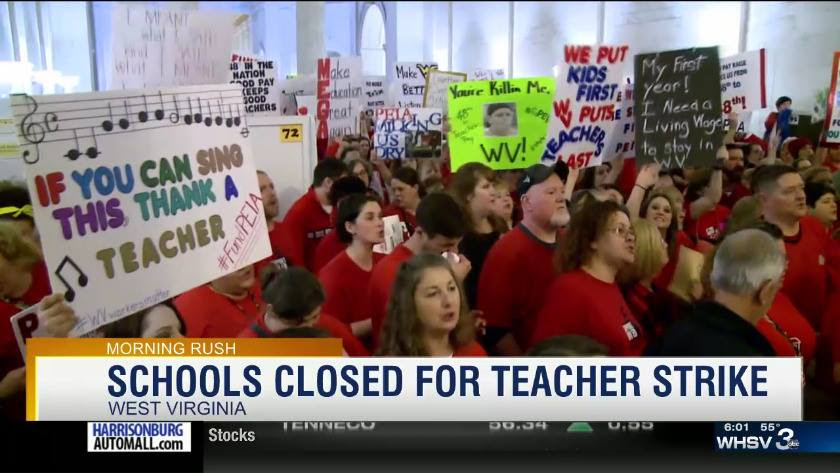Feeding the schoolkids was a
tactical masterstroke (as doing the right thing so often is)...
“What are their demands?” — that the teachers are
making, as opposed to the demands that careless journalists say they are
making; and then I’ll present a grab bag of interesting characteristics
worth noting, partly about West Virginia, partly about this strike.
I’ll conclude with some remarks on the role of the Democrat Party in
creating the conditions that led to the strike....
we enter phase three! The rank and
file rejected the deal, turning the strike into a wildcat strike. ..... by Lambert Strether
If you continue reading Ed Notes you will learn everything there is to share about teacher actions in W. Virginia and Oklahoma - and hopefully other places too until you can't take anymore.
For the 2nd West Virginia strike article of the day that I'm posting, this one looks like a goodie even though it was posted over a week ago. Look at the opening line up top. Feeding the kids. I can just imagine some of the selfish oafs who comment on mine and other blogs thinking, "how social justicy" - why worry about the kids?
I still have at least one more to post later around midnight. (I want to give readers a chance to get to the articles.) Why am I focusing on WV and OK -- lessons galore -- and not only what you may be hearing from the left the center or the right. By reading everything we can come up with some conclusions - hopefully - on how we may be affected here in NYC and beyond. The answer may very well be not at all.
Note the section in red with the * - these 3 unions have not gotten along and according to a West V teacher I spoke to, there is still a lot of tension and resistance to working together from union leaders at the top --- yes, this crap never goes away.
I still have to report on the March 10 Saturday night event attended by 300 people who heard directly from 3 WV teachers.
https://www.nakedcapitalism.com/2018/03/notes-west-virginia-teachers-strike-2018.html#comment-2933610
By Lambert Strether of Corrente.
Obviously, the West Virgina teachers strike is a big story, and
potentially an enormous one, especially if it turns out to be the more
successful cousin of the
the Wisconsin State Capitol occupations of 2011 which followed
Tahrir Square and preceded
Occupy proper.
(As we’ll see below, “teachers strike” is a bit of a misnomer, and
that’s important, but I think we’re stuck with the phrase.) So I ought
to present a general theory, or at least a hot take, but on working
through the sources as best I could, I realized how little I knew of
realities on the ground[1], so my ambitions for this post will be more
modest. First, I’ll review the state of play; then, I’ll reinforce the
demands — one of the nice things about a strike is that there is an
answer
to the question “What are their demands?” — that the teachers are
making, as opposed to the demands that careless journalists say they are
making; and then I’ll present a grab bag of interesting characteristics
worth noting, partly about West Virginia, partly about this strike.
I’ll conclude with some remarks on the role of the Democrat Party in
creating the conditions that led to the strike.
First, one piece of background. There was a massive and successful eleven-day West Virginia teachers strike in 1990.
The Charleston Gazette-Mail:
In March 1990, teachers across West Virginia refused to go to work
and headed to the picket line, shutting down hundreds of schools for 11
days. They walked out after legislative leaders and Gov. Gaston Caperton
were unable to come to an agreement on a package of pay raises.
The 1990 strike is often referred to as West Virginia’s first
statewide teacher strike, but eight of the state’s 55 counties didn’t
participate in the walkout.
Teachers returned to work after union leaders secured promises from
state Senate President Keith Burdette and House Speaker Chuck Chambers
to address teacher pay and other issues.
Among other results of the strike, teachers received a $5,000 pay
increase, phased in over three years. That boosted West Virginia
teachers’ salaries from 49th in the nation before the strike to 34th
after the raises were implemented. Teachers also got new support and
training programs, and money was set aside for faculty senate groups in
every school, in an effort to give teachers more of a voice in education
policy decisions.
Then as now, the strike was “unlawful” without being “illegal” (
I’m not sure I understand that, either)
but in any case nobody was arrested (even though, unbelievably,
teachers have no right to collective bargaining in West Virginia, and
their wages are set by the legislature). Two other differences leap out:
In 2018, all 55 counties participated (the hash tag is
#55strong), and this time, the rank and file rejected the “secured promises” obtained from the Governor by the union leadership.
The State Of Play
So far, the strike has gone through three phases: The build-up, the
walkout, and the wildcat strike. Let’s look at each phase in turn.
Labor Notes has a good retrospective
of the thinking and organizing during the build-up to the strike, sadly
(or fortunately?) not made visible to the rest of the world by the
press:
The first rumblings began late last year, when a group of teachers
formed a secret Facebook page[2] and started planning a “lobby day” at
the state capital on Martin Luther King Day, when they knew the
legislature would be in session. Word spread, and soon the West Virginia
Education Association, the state’s NEA affiliate, was planning an
official rally.
“This was almost completely a grassroots movement,” said Erica
Newsome, an English teacher in Logan County. “The unions kind of
followed us.”
Organizers estimate 150 people showed up. “The rally was kind of
small,” said Ashlea Bassham, a teacher at Chapmanville Regional High
School, “but then it just sort of happened.”
Teachers and school service employees started holding walkout votes
county by county. West Virginia has two statewide teachers unions,
affiliates of the AFT and NEA, which often compete for membership. There
is also the West Virginia School Service Professional Association, or
WVSSPA,* which represents bus drivers, cafeteria workers, custodians, and
clerical workers. But teachers and school service employees decided
that in this case, any school employee could vote—whether they were a
member of any one of the unions or no union at all.
We now enter the walkout phase, marked by Capitol protests and rallies:
Strikers converged on the capital again. This time there were 1,000
teachers, public employees, students, and parents at the statehouse.
“The gallery filled up too quick for me and some co-workers to go
in,” said Bassham, “So we waited in the breezeway to talk to our state
legislators. Some of our representatives were willing to talk and take a
minute and listen, and some of them had their heads down, walking
really quickly.”
The legislature responded by announcing a temporary freeze to Public
Employees Insurance Agency (PEIA) premium increases, and offered a two
percent pay raise in the first year.
At this point (February 27), the union leadership declared victory[3].
The Payday Report:
After 4 days of striking, the West Virginia teachers’ union has reached an agreement to end their historic work stoppage.
Under the deal, the teachers would get a 5% raise during the first year. Initially, teachers had been offered 1% raise.
The state also agreed to appoint a task force to look into improving
the troubled Public Employee Insurance Agency [PEIA], which insures the
teachers.
The teachers will return to classes on Thursday after a brief cooling-off period.
In fact, that didn’t happen, and we enter phase three!
The rank and
file rejected the deal, turning the strike into a wildcat strike. Jacobin interviewed Jay O’Neal, a middle-school teacher and union activist in Charleston:
[O’NEAL]: As is the case these days, everybody was on their phones,
trying to follow the news to get a sense of what was going on.
Within ten minutes, we found out through the governor’s press
conference [not a good look!] that a deal had been reached. Teachers and
school staff would get a 5 percent pay raise, and 3 percent for all
state employees. The governor also said that a task force would be set
up to figure out how to improve PEIA, our statewide health insurance
plan for public sector workers.
Fifteen minutes after the press conference, union leaders came out
and addressed the crowd. The basic problem was that they presented this
deal as a victory. They told us we’d be out on strike one more day, then
return to school on Thursday.
People were up in arms, really frustrated. Of course, a 5 percent
raise is great, but what we’ve been really fighting for in this struggle
is PEIA. This has been a huge issue, causing problems for years.
They’ve been cutting our health insurance over and over, making it
really expensive to survive.
So when it was announced that all we got on PEIA was a task force, people were upset.
And:
In my county at least, the sentiment is that
we’re not going back to work until there’s solid proof that our demands are going to be met. Our biggest fear is that they’re just going to keep pushing back the question of PEIA.
(There was also a hilarious subplot where Governor Justice pulled
“$58 million out of thin air”
to pay for the raises, IIRC continuing a storied tradition in the
state.) And in fact, the rank and file were right on the money, as
hilarity ensues in the state legislature. The
Charleston Gazette and Mail:
On Saturday evening, the Senate Finance Committee took up a pay raise
bill passed by the House, and reduced the pay increase for teachers,
school service workers and State Police troopers from 5 percent to 4
percent.
But the Senate then, mistakenly, passed the House version of the bill
with the 5 percent raise, rather than the 4 percent version. After
Senate leaders announced the mistake, senators walked back their passage
vote and certain procedural votes, and passed the bill with a 4 percent
raise after 9:30 p.m. Saturday.
House members wouldn’t agree to that change, and both sides appointed
three members to a conference committee, which will try to hash out the
differences on the bill.
“At this point, the three organizations announce that we are out
indefinitely — we will not accept the 4 percent,” said Dale Lee,
president of the West Virginia Education Association, speaking on behalf
of his group, as well as the state arm of the American Federation of
Teachers and the West Virginia School Service and Personnel Association,
following Saturday’s committee vote. “Until this bill passes at 5
percent, we will be out indefinitely.”
Immediately after the committee amendment vote (the first time around), jeering broke out from the Senate gallery.
(Whether the Senate leadership was incompetent, or engaged in crude delaying tactics I cannot say.)
The Conference Committee might meet Sunday, but
the Senate reconvenes Monday at 11AM. So that is where we are.
What Are Their Demands?
All I’m going to do here is contrast the lazier headlines with what the striking teachers are saying. The headlines:
But as we have already seen,
health insurance (PEIA) was a key issue[4], besides the raise; that’s what teacher Jay O’Neal says above, that’s what teacher Katie Endicott
told the New York Times, that’s what teacher Samantha Nelson
told CNN, and that’s what
the Charleston Gazette and Mail found in its reporting:
Many school employees interviewed say maintaining Public
Employees Insurance Agency health insurance costs and benefits at their
current levels is a bigger issue than pay increases. PEIA Finance Board
members, at the governor’s urging, have delayed premium increases and
benefit cuts, but teachers say that just delays the pain, and a
long-term solution is needed.
That’s also what
the Los Angeles Times found:
At the heart of the matter, teachers say, isn’t their salaries. It’s their soaring healthcare costs.
“We’ve seen [people say] ‘teachers are not happy with the 5%
increase’ — that’s not it at all,” said Mary Clark, 49, a fifth-grade
teacher in Monongalia County. “That’s not what kept us out. It’s the
insurance. That’s the big deal.”
In West Virginia, teachers and other state employees receive health coverage through the Public Employees Insurance Agency.
The state program is funded 80% by employers and 20% by employees.
That means as healthcare costs continue to rise significantly, the
program’s long-term solvency requires “significant revenue increases in
employer and employee premiums” over the next five years, according to
an October 2017 financial report prepared for PEIA.
In other words, employees are going to need to pay up. “They are wanting to raise our rates,” Clark said.
But there’s a problem with that: After teaching for a little more
than 10 years, “I’ve not seen [my take-home pay] go up any at all,” not
even counting inflation, Clark said. If her healthcare costs increase,
“that’s not feasible.”
Which is obvious when you think about it: What’s the point of a raise
if your insurance company takes the money right out of your pocket,
like you’re some sort of pass-through?
Bottom line here is to
beware of any source that presents the raise
(4% vs 5%) as the only, or even the main issue. That includes, as we
have seen, much of the press, but also the Governor and the legislature,
and the union leadership (at least as far as I can find). PEIA needs to
be fixed, and not by some pissant kick-the-can-down-the-road [family
blogging] commission, either.
West Virginia on the Ground
Now the promised grab bag: Items I noticed collecting information for
this story that seem to be unique to West Virginia. The first two
relate to the history and culture of the state; the final three are
about this strike in particular.
Item one: The word “county.” Teacher O’Neal uses it in his interview above:
From below,
I can only really speak about the situation in my county,
which is local to Charleston. We decided to have a meeting at 1 PM to
try to straighten things out and to get some correct information. It was
all super last minute, we had to plan it in a couple of hours. We met
in a nearby church. The room was absolutely packed, with pews and aisles
filled way past capacity.
And I ran across teachers talking about their counties constantly.
Now, I don’t know what to make of this. I am very much from my place or
patch in Maine, but I situate myself more in my town, or at the
intersection of the Penobscot and the Stillwater Rivers; I don’t think
myself as being from Penobscot County at all. Perhaps some West Virginia
readers can enlighten us?
Item two: West Virgina has a storied labor history. State Senator Richard Ojeda, a Democrat, amazingly enough, in
the Morgan County, USA blog:
“The teachers of West Virginia are not just fighting for themselves,
our children or all public employees,” Ojeda wrote. “In my view,
teachers in West Virginia are joining a fight for the soul and spirit of
West Virginia that started hundreds of years ago.”
“Hundreds of years ago, investors came to West Virginia and purchased
most of the land for all but nothing. Even today, you will be hard
pressed to find many people in West Virginia who own their mineral
rights.”
“They wanted our salt, timber and coal. They came in, paid our people
essentially nothing for it and then put in the railroad. West Virginia
has always been a colony.”
I’ll stop there, but it’s worth a read in full. (It’s is a rolled up
Tweet storm from Ojeda, but I wanted to give a local site some hits.)
Item three, now on the strike itself: Feeding the schoolkids was a
tactical masterstroke (as doing the right thing so often is). From
Today:
During the four-day strike, teachers throughout West
Virginia went out of their way to provide students with food. Teachers
and staff at Horace Mann Middle School in Charleston prepared bagged
lunches to send home with their students before they hit the picket
line. Others worked with local food pantries to drop food off at
students’ homes.
Item four:
All school unions are involved, not just the teachers, unlike the 1990 strike[6] (making the phrase “teachers strike” a misnomer).
The Charleston Gazette Mail:
Teachers, this time joined by school service personnel,
walked off the job Thursday…. The 1990 strike also did not involve
public school service personnel, a category that generally includes
non-teachers, like bus drivers and cooks.
This is a second tactical masterstroke (besides, again, being the
right thing to do). Awkward situations described in this photo caption
are avoided:
Protesters block school buses from leaving a garage during the West Virginia teachers’ strike on March 9, 1990.
This time, the bus drivers walked out with the teachers (which certainly does make it easier to enforce the school closures).
Item five: The teachers (and cooks and bus drivers and janitors and
all school employers) are, as Ojeda points out, fighting for
all West Virginia public employees, not just themselves, since PEIA stands for “ Public Employee Insurance Agency.” A third tactical masterstroke (and again, the right thing to do).
Actually, having written the items, I now see a common thread between them, or at least for two through five: Solidarity.
Conclusion
“West Virginia Spring” may
be over-stating the case[5], but the teachers strike — need a better
phrase! — is already an interesting and potentially important flashpoint
(especially if the teachers in
Oklahoma follow their lead,
or even Florida, if Florida teachers decide they don’t want to be
security guards on top of everything else). Before I close, I did
promise I’d have a word to say about the role of the Democrat Party in
all this.
First, Governor Justice is a piece of work.
Vice:
The towering Justice, who owns coal companies, resorts,
and a host of other businesses, has emerged as the bete noire of the
saga. He won his office running a Trump-like campaign as an outsider businessman, but
flipped from Democrat to Republican at a Trump rally in Huntington last summer. As West Virginia’s only
billionaire, Justice has developed a reputation for not paying taxes or federal fines—a fact frequently touted on signs and in conversations among the teachers striking for better pay.
Governor Justice, in other words, besides being self-funded, is a
Blue Dog with the courage of his (Republican) convictions (rare, I
know). He is, that is, exactly the sort of candidate that
the DCCC is trying to foist on us to make sure, among other things, that #MedicareForAll “never, ever comes to pass.”
Second, West Virginia troubles with PEIA are due to tax policies
suppported by both parties, very much including a second Blue Dog, Joe
Manchin.
HuffPo:
A decade ago, West Virginia began gradually winding down certain
business taxes that could have helped pay for the across-the-board
raises that teachers haven’t seen in four years. They also could have
helped fill the funding shortfall in the Public Employee Insurance
Agency, or PEIA, which many workers list as their top concern.
Although Republicans now control both chambers of the statehouse, the
tax cuts that Over the following years, the state wound down its
corporate net income tax rate from 9 to 6.5 percent, and phased out its
business franchise tax. It also slashed its tax on groceries from six to
three percent, and later did away with it entirely under Manchin’s
successor, Democrat Earl Ray Tomblin. Over the same span, the state also
created a family tax credit, increased its homestead exemption and got
rid of an alternative minimum tax and corporate charter tax, according
to the West Virginia Center on Budget and Policy.
All told, those cuts diminished state revenue by more than $425
million each year, the center estimates.squeezed the state budget were a
bipartisan undertaking. Then-Gov. Joe Manchin, a Democrat who’s now one
of the state’s two senators in Washington, had urged legislators to
pursue the tax cuts in 2006, arguing that West Virginia needed to slash
taxes on corporations in order to be competitive with other states.
(Of course, the best way to fix PEIA would be to remove health insurance from its remit entirely by passing #MedicareForAll.
Manchin, naturally, does not support that.)
I’ll close with Th
e New Yorker’s perspective:
“Appalachia was not different from the rest of America,”
the Appalachian historian Ronald Eller wrote ten years ago, in his
history of the region, “Uneven Ground.” “It was in fact a mirror of what
the nation was becoming.” Maybe that is the real source of the
suspense, in the conflict between educators wearing red and the
Trump-supporting governor: it isn’t at all obvious whether these
teachers are professionals in a middle-class place or workers whose
footsteps get tracked by an app[7], because it isn’t at all obvious what
the nation is becoming.
Well….
NOTES
[1] Whinging a bit: Google News gets worse and worse, so it’s hard to
find stuff; newsrooms are being slashed, which means there’s less to
find;
the labor beat,
at least in the newsroom, is a thing of the past; and social media
nuked a lot of the small blogs (and Facebook search is miserably
inadequate, even if it weren’t so toxic I can’t bring myself to use it
anymore). All of which is by way of asking readers, especially West
Virginia readers, for local sources I should be looking at. Surely there
are some small West Virginia political blogs worth reading?
[2] Not, of course, “secret” to
Facebook. Gawd knows who Facebook was selling that data to.
[3] See this clickbait tear-jerker from CNN: “
This 6th-grader helped end West Virginia teachers’ strike.” Always “this.” Never “these.”
[4] Stoller comments:
[5] Although it’s worth noting that the Quebec
printemps érable — a really horrible pun, think about it —
student strike was also in the education sector.
[6] “Higher” education should take this to heart, I think.
[7] This is a reference not only to
Amazon warehouse workers, but to West Virginia teachers.
Katie Endicott:
“They implemented Go365, which is an app that I’m supposed to download
on my phone, to track my steps, to earn points through this app. If I
don’t earn enough points, and if I choose not to use the app, then I’m
penalized $500 at the end of the year.”



![[Photo: A large crowd of teachers gather ouside of West Virginia's state capitol during the teachers strike.]](https://rewire.news/wp-content/uploads/2018/03/Strike-1-740x525.png)






